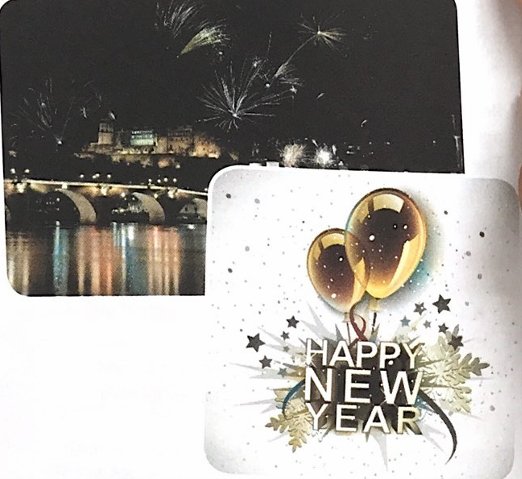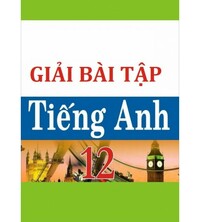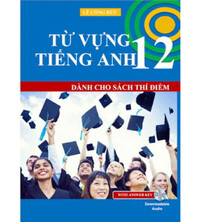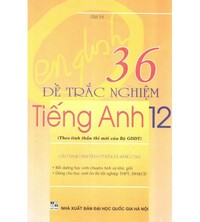3G. Speaking - Unit 3. Customs and culture - SBT Tiếng Anh 12 Friends Global
1 Listen to a student doing the task below. Which of the four prompts (A-D) does she not mention?2 Read Speaking Strategy. Complete phrases (1-4) with the words below.
Bài 1
Topic-based presentation
I can talk about a cultural event of festival.
1 Listen to a student doing the task below. Which of the four prompts (A-D) does she not mention?
(Hãy lắng nghe một học sinh làm bài tập dưới đây. Cô ấy không đề cập đến gợi ý nào trong bốn gợi ý (A-D)?)
Look at the pictures. Then talk for about one minute about how people in your country celebrate International Women's Day.
(Nhìn vào những bức tranh. Sau đó nói khoảng một phút về cách người dân nước bạn kỷ niệm Ngày Quốc tế Phụ nữ.)
A What is the history behind the celebration?
B Do people usually give or receive gifts and/or cards?
C Are there any other annual traditions?
D Do you personally take part in any celebrations?

Phương pháp giải:
Bài nghe
Well, International Women’s Day is on 8 March every year. As far as the history of the event is concerned, I’m not really an expert. I think it all began about a hundred years ago, around the time that women were trying to win the right to vote. In my country, it was originally a kind of political occasion. Turning now to the topic of gifts, the most common one is flowers. It is traditional for men to give flowers to the important women in their lives – this includes mothers, daughters, wives, and so on. And children often take gifts to school for their female teachers. I know that in some countries, there is the custom of giving a particular type of flower as a gift – and a particular colour. This is not the case in my country. That brings me to the subject of marches on International Women’s Day. In my country, there’s sometimes a march on International Women’s Day but it isn’t really a custom. I know that in some other countries, there is always a march. The purpose of the marches is to demand equal rights for women. There’s something else I’d like to talk about: national holidays. International Women’s Day used to be a day off work for everyone. I think this is still true in some countries, but not in my country. I think it’s a really important day, and should become a national holiday again in my country. That’s my opinion anyway!
Tạm dịch
Vâng, ngày Quốc tế Phụ nữ là ngày 8 tháng 3 hàng năm. Về lịch sử của sự kiện này, tôi không thực sự là một chuyên gia. Tôi nghĩ mọi chuyện đã bắt đầu khoảng một trăm năm trước, vào khoảng thời gian mà phụ nữ đang cố gắng giành quyền bầu cử. Ở nước tôi, ban đầu nó là một loại dịp chính trị. Bây giờ chuyển sang chủ đề quà tặng, phổ biến nhất là hoa. Theo truyền thống, đàn ông sẽ tặng hoa cho những người phụ nữ quan trọng trong cuộc đời họ - bao gồm mẹ, con gái, vợ, v.v. Và trẻ em thường mang quà đến trường cho các cô giáo của mình. Tôi biết rằng ở một số quốc gia, có phong tục tặng một loại hoa cụ thể làm quà – và một màu sắc cụ thể. Đây không phải là trường hợp ở đất nước tôi. Điều đó đưa tôi đến chủ đề tuần hành nhân Ngày Quốc tế Phụ nữ. Ở nước tôi, đôi khi có cuộc diễu hành vào Ngày Quốc tế Phụ nữ nhưng đó không thực sự là một phong tục. Tôi biết rằng ở một số nước khác luôn có cuộc diễu hành. Mục đích của cuộc diễu hành là đòi quyền bình đẳng cho phụ nữ. Có một điều khác tôi muốn nói đến: những ngày lễ quốc gia. Ngày Quốc tế Phụ nữ từng là ngày nghỉ làm của tất cả mọi người. Tôi nghĩ điều này vẫn đúng ở một số nước, nhưng ở nước tôi thì không. Tôi nghĩ đây là một ngày thực sự quan trọng và sẽ lại trở thành ngày lễ quốc gia ở đất nước tôi. Dù sao đó cũng là ý kiến của tôi!
Lời giải chi tiết:
A What is the history behind the celebration?
(Lịch sử đằng sau lễ kỷ niệm là gì?)
Thông tin: “I think it all began about a hundred years ago, around the time that women were trying to win the right to vote.”
(Tôi nghĩ mọi chuyện đã bắt đầu khoảng một trăm năm trước, vào khoảng thời gian phụ nữ đang cố gắng giành quyền bầu cử.)
B Do people usually give or receive gifts and/or cards?
(Mọi người có thường xuyên tặng hoặc nhận quà và/hoặc thiệp không?)
Thông tin: “is traditional for men to give flowers to the important women in their lives – this includes mothers, daughters, wives, and so on. And children often take gifts to school for their female teachers.”
(Truyền thống của đàn ông là tặng hoa cho những người phụ nữ quan trọng trong cuộc đời họ – bao gồm mẹ, con gái, vợ, v.v. Và các em thường mang quà đến trường cho các cô giáo của mình.)
C Are there any other annual traditions?
(Có truyền thống hàng năm nào khác không?)
Thông tin: “In my country, there’s sometimes a march on International Women’s Day but it isn’t really a custom.”
(Ở nước tôi thỉnh thoảng có diễu hành vào Ngày Quốc tế Phụ nữ nhưng đó không hẳn là một phong tục.)
D Do you personally take part in any celebrations?
(Cá nhân bạn có tham gia vào lễ kỷ niệm nào không?)
Không có thông tin.
=> Chọn D
Bài 2
Speaking Strategy
Make sure that you mention all of the prompts in the task. Learn some useful phrases for changing the subject or moving on to the next point.
(Chiến lược nói
Đảm bảo rằng bạn đề cập đến tất cả các lời nhắc trong nhiệm vụ. Tìm hiểu một số cụm từ hữu ích để thay đổi chủ đề hoặc chuyển sang điểm tiếp theo.)
2 Read Speaking Strategy. Complete phrases (1-4) with the words below.
(Đọc Chiến lược nói. Hoàn thành các cụm từ (1-4) với các từ bên dưới.)
|
far |
now |
something |
subject |
1 As _______ as the history of the event is concerned,...
2 Turning _______ to the topic of...
3 That brings me to the _______ of …
4 There's _______ else I'd like to talk about:...
Phương pháp giải:
*Nghĩa của từ vựng
far: xa
now: bây giờ
something: thứ gì đó
subject: chủ đề
Lời giải chi tiết:
|
1 far |
2 now |
3 subject |
4 something |
1 As far as the history of the event is concerned,...
(Xét về lịch sử của sự kiện này,...)
2 Turning now to the topic of...
(Bây giờ chuyển sang chủ đề...)
3 That brings me to the subject of …
(Điều đó đưa tôi đến chủ đề…)
4 There's something else I'd like to talk about:...
(Còn một điều nữa tôi muốn nói đến:...)
Bài 3
3 Listen again. Match phrases (1-4) from exercise 2 with endings (a-f) below. There are two extra endings.
(Lắng nghe một lần nữa. Nối các cụm từ (1-4) trong bài tập 2 với các đuôi (a-f) bên dưới. Có hai đuôi bị thừa.)
a ____ marches on International Women's Day.
b ____ home-made greetings cards.
c ____ national holidays.
d ____ gifts, the most common one is flowers.
e ____ I'm not really an expert.
f ____ celebrations at school.
Lời giải chi tiết:
|
1 – e |
2 – d |
3 – a |
4 – c |
1 – e
As far as the history of the event is concerned, I'm not really an expert.
(Về lịch sử của sự kiện này, tôi thực sự không phải là chuyên gia.)
2 – d
Turning now to the topic of gifts, the most common one is flowers.
(Bây giờ chuyển sang chủ đề quà tặng, phổ biến nhất là hoa.)
3 – a
That brings me to the subject of marches on International Women's Day.
(Điều đó đưa tôi đến chủ đề diễu hành nhân Ngày Quốc tế Phụ nữ.)
4 – c
There's something else I'd like to talk about: national holidays.
(Còn một điều nữa tôi muốn nói đến: những ngày lễ quốc gia.)
Bài 4
Look at the pictures below. Then talk for about one minute about how people in your country celebrate New Year.
(Nhìn vào những hình ảnh dưới đây. Sau đó nói khoảng một phút về cách người dân ở nước bạn ăn mừng năm mới.)
A Does food or drink play a part in the celebration?
B Do people usually give or receive gifts and/or cards?
C Are there any other traditions?
D What do you personally usually do to celebrate?

4 Look at the task above. Make notes for each of the four prompts.
(Nhìn vào nhiệm vụ trên. Ghi chú cho từng gợi ý trong số bốn gợi ý.)
1 Does food or drink play a part in the celebration?
____________________________________
2 Do people usually give or receive gifts and / or cards?
____________________________________
3 Are there any other traditions?
____________________________________
4 What do you personally usually do to celebrate?
____________________________________
Phương pháp giải:
Look at the pictures below. Then talk for about one minute about how people in your country celebrate New Year.
(Nhìn vào những hình ảnh dưới đây. Sau đó nói khoảng một phút về cách người dân ở nước bạn ăn mừng năm mới.)
A Does food or drink play a part in the celebration?
B Do people usually give or receive gifts and/or cards?
C Are there any other traditions?
D What do you personally usually do to celebrate?

4 Look at the task above. Make notes for each of the four prompts.
(Nhìn vào nhiệm vụ trên. Ghi chú cho từng gợi ý trong số bốn gợi ý.)
1 Does food or drink play a part in the celebration?
____________________________________
2 Do people usually give or receive gifts and / or cards?
____________________________________
3 Are there any other traditions?
____________________________________
4 What do you personally usually do to celebrate?
____________________________________
Lời giải chi tiết:
1 Does food or drink play a part in the celebration?
- Special dishes prepared
- Traditional foods and sweets
- Festive drinks (alcoholic and non-alcoholic)
2 Do people usually give or receive gifts and / or cards?
- Exchange of gifts
- New Year cards given to family and friends
- Some receive money (lucky money)
3 Are there any other traditions?
- Wearing new clothes
- Family gatherings
- Cleaning the house to welcome the New Year
4 What do you personally usually do to celebrate?
- Reflect on the past year and make resolutions for the new year
- Enjoy a special meal together
- Watch fireworks
(1 Thức ăn và đồ uống có đóng vai trò gì trong buổi lễ không?
- Chế biến các món ăn đặc biệt
- Đồ ăn và đồ ngọt truyền thống
- Đồ uống lễ hội (có cồn và không cồn)
2 Mọi người có thường xuyên tặng hoặc nhận quà và/hoặc thiệp không?
- Trao đổi quà tặng
- Thiệp Tết tặng người thân, bạn bè
- Một số nhận được tiền (tiền lì xì)
3 Có truyền thống nào khác không?
- Mặc quần áo mới
- Tụ tập gia đình
- Dọn dẹp nhà cửa đón năm mới
4 Cá nhân bạn thường làm gì để ăn mừng?
- Nhìn lại một năm đã qua và đưa ra giải pháp cho năm mới
- Cùng nhau thưởng thức bữa ăn đặc biệt
- Xem pháo hoa)
Bài 5
5 Now do the task, using your notes from exercise 4.
(Bây giờ hãy thực hiện nhiệm vụ, sử dụng ghi chú của bạn từ bài tập 4.)
Lời giải chi tiết:
In my country, New Year celebrations are filled with vibrant traditions and activities. Food and drink play a significant role; special dishes are prepared, and traditional foods and sweets are enjoyed. Both alcoholic and non-alcoholic festive drinks are a big part of the celebration.
People usually exchange gifts and give New Year cards to family and friends. It's also common for some to receive lucky money as a symbol of good fortune for the coming year.
Other traditions include wearing new clothes to symbolize a fresh start, and families often gather together to celebrate. Cleaning the house is another important tradition to welcome the New Year and get rid of any bad luck from the past year.
Personally, I like to reflect on the past year and make resolutions for the new year. I enjoy a special meal with my family, and we always make sure to watch the fireworks together. These traditions help us start the New Year with hope and positivity.
(Ở nước tôi, lễ đón năm mới tràn ngập những truyền thống và hoạt động sôi động. Thức ăn và đồ uống đóng một vai trò quan trọng; các món ăn đặc biệt được chuẩn bị và thưởng thức các món ăn truyền thống cũng như đồ ngọt. Cả đồ uống lễ hội có cồn và không cồn đều là một phần quan trọng của lễ kỷ niệm.
Mọi người thường trao đổi quà tặng và tặng thiệp năm mới cho gia đình và bạn bè. Một số người cũng thường nhận tiền lì xì như một biểu tượng của sự may mắn trong năm tới.
Các truyền thống khác bao gồm mặc quần áo mới để tượng trưng cho một khởi đầu mới và các gia đình thường tụ tập cùng nhau để ăn mừng. Dọn dẹp nhà cửa là một truyền thống quan trọng khác để chào đón năm mới và thoát khỏi mọi điều xui xẻo trong năm vừa qua.
Cá nhân tôi thích nhìn lại một năm đã qua và đưa ra những quyết tâm cho năm mới. Tôi thưởng thức một bữa ăn đặc biệt cùng gia đình và chúng tôi luôn đảm bảo cùng nhau xem pháo hoa. Những truyền thống này giúp chúng ta bắt đầu năm mới với niềm hy vọng và sự tích cực.)
Search google: "từ khóa + timdapan.com" Ví dụ: "3G. Speaking - Unit 3. Customs and culture - SBT Tiếng Anh 12 Friends Global timdapan.com"







